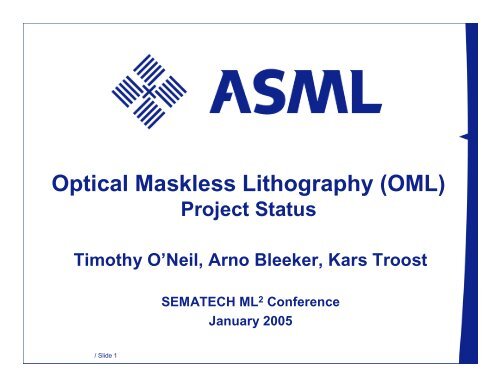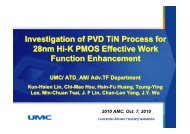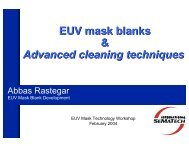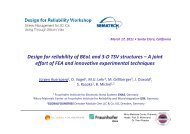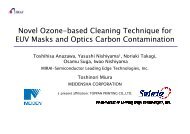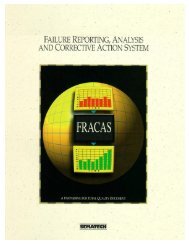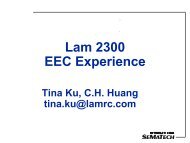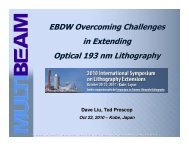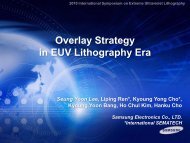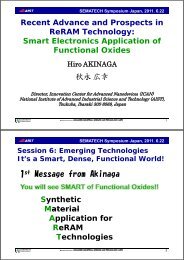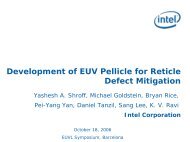ASML/Micronic Technology Developments - Sematech
ASML/Micronic Technology Developments - Sematech
ASML/Micronic Technology Developments - Sematech
You also want an ePaper? Increase the reach of your titles
YUMPU automatically turns print PDFs into web optimized ePapers that Google loves.
Optical Maskless Lithography (OML)<br />
Project Status<br />
Timothy O’Neil, Arno Bleeker, Kars Troost<br />
/ Slide 1<br />
SEMATECH ML2 Conference<br />
January 2005
Agenda<br />
Introduction and Principles of Operation<br />
DARPA Program Activities<br />
w Contrast Device Test Stands<br />
w Systems Engineering<br />
w Modeling Results<br />
<strong>Micronic</strong> SIGMA 7300 results<br />
Summary and Conclusions<br />
/ Slide 2
Project Status within <strong>ASML</strong><br />
<strong>ASML</strong> views OML as natural extension of the optical<br />
lithography roadmap, especially for low wafer/mask situations<br />
Throughout 2004, technical and commercial studies have<br />
been performed<br />
w Technical<br />
• SLM contrast device<br />
Projection and illumination optics<br />
Datapath<br />
w Commercial<br />
Customer applications<br />
Product positioning and roadmap<br />
/ Slide 3
Advantages of OML<br />
Fab transparency (e.g. same resist platform as mask-based)<br />
Advances in conventional mask-based lithography are readily<br />
extendable to OML<br />
w Wavelength reduction<br />
w Immersion<br />
w OPC<br />
w Strong phase-shifting<br />
Maskless lithography provides<br />
w Reduced cost of introduction and faster time-to-market for new designs<br />
w Reduced cost of manufacturing of low-volume designs<br />
Leverages TWINSCAN® platform and optics expertise at<br />
customer and within <strong>ASML</strong><br />
/ Slide 4
OML: Projected Key Specifications<br />
<strong>Technology</strong> node: 65/45nm half pitch<br />
Wavelength: 193 nm<br />
Illumination: Conventional, Annular, Dipole,<br />
Quasar, .....<br />
Throughput: 5 wph (300mm)<br />
/ Slide 5<br />
Optical<br />
Maskless<br />
Scanner<br />
TWIN<br />
SCAN<br />
XT<br />
MASK<br />
LESS
Optical Maskless Lithography<br />
System Overview<br />
Concept<br />
w Illumination light is reflected from a<br />
dynamic pattern generating device<br />
(Spatial Light Modulator, or SLM)<br />
w SLM contains a section of a desired<br />
circuit pattern<br />
w Pattern is imaged onto a substrate<br />
through a high de-magnification<br />
projection lens<br />
First <strong>Technology</strong> Use: <strong>Micronic</strong><br />
w Sigma 7300 photomask writing<br />
system (results reported in this<br />
meeting)<br />
w One SLM (16 µm mirrors, 1 MPixel)<br />
(1): Sandström, et al. <strong>Micronic</strong> Laser Systems. “Pattern Generation with SLM Imaging”.<br />
Proceedings of SPIE Vol. 4562 (2002)<br />
/ Slide 6<br />
(1)
DUV<br />
Laser<br />
Imaging Engine of the OML Scanner<br />
The Spatial Light Modulator (SLM)<br />
OML Scanner<br />
Illum<br />
Optics<br />
SLM Contrast<br />
Devices<br />
>100x Proj<br />
Optics<br />
Image<br />
Plane<br />
/ Slide 7<br />
Example Contrast<br />
Device:<br />
<strong>Micronic</strong> / Fraunhofer SLM<br />
16 µm square tilting pixels<br />
8 mm x 33mm active area<br />
512 x 2048 pixels<br />
(1.048 MPixels per SLM)<br />
Multiple devices are used<br />
in parallel to achieve<br />
throughput requirements<br />
Multiple contrast device technologies are being evaluated.<br />
(2) Sandström, et al. <strong>Micronic</strong> Laser Systems. “Pattern Generation with SLM Imaging”.<br />
Proceedings of SPIE Vol. 4562 (2002)<br />
(2)<br />
(2)
Systems Engineering<br />
Alternative Pixel Geometries<br />
Tilt<br />
Phase-Step Tilt<br />
Piston<br />
<strong>ASML</strong> is actively engaging with all SLM suppliers to evaluate<br />
actuation principles and alternatives.<br />
/ Slide 8<br />
Operating Principle Phase & Intensity Range<br />
Phase interference between<br />
each half of mirror creates net<br />
intensity thru tilt.<br />
Like tilt with λ/4 phase step.<br />
Provides balanced intensity<br />
range for 0 o and 180 o phase.<br />
Pure phase manipulation.<br />
Interference with neighboring<br />
mirrors manipulates intensity.<br />
0 o phase: 0% - 100%<br />
180 o phase: 0% - 4%<br />
0 o phase: 0% - 50%<br />
180 o phase: 0% - 50%<br />
Any phase between 0 o and<br />
360 o : 0% - 100%
Tilt SLMs<br />
Principle of Image Formation<br />
Bright (full reflection into<br />
pupil) when mirror is at zero<br />
tilt<br />
Gray Tone (partial reflection<br />
into pupil) at intermediate tilt<br />
positions<br />
Attenuated Phase Shift<br />
(reflection into pupil with 180o phase shift) when mirror tilt is<br />
beyond λ/4 height difference<br />
edge-to-edge<br />
Capable of emulating the<br />
imaging capabilities of binary<br />
and att-PSM masks.<br />
/ Slide 9<br />
Tilt Mirror Intensity
Phase-Step Tilt SLMs<br />
emulate alt-PSM and<br />
CPLTM Masks<br />
Dark (no reflection into pupil)<br />
when mirror is at zero tilt<br />
Bright (70% reflection),<br />
symmetrical in positive and<br />
negative phase<br />
Gray Tone (partial reflection<br />
into pupil) at intermediate tilt<br />
positions for both positive and<br />
negative phase<br />
/ Slide 10<br />
Im(Refl)<br />
[Phase]<br />
Re(Refl)<br />
[Amplitude]<br />
Amplitude<br />
+0.7<br />
0<br />
-0.7<br />
Clear<br />
Dark<br />
Attenuated<br />
Shifted<br />
Tilt α
Piston SLMs emulate<br />
also alt-PSM, CPLTM<br />
and multi-phase masks<br />
Gray Tone (grouped mirrors<br />
for destructive interference) by<br />
alternating pistons in<br />
checkerboard pattern.<br />
w Gray-tone based on relative<br />
heights in checkerboard<br />
w Phase based on the average<br />
height of the checkerboard<br />
Phase Edge (line interference)<br />
by alternating rows / columns<br />
of height.<br />
/ Slide 11
Writing Strategy:<br />
Loading and Writing a Pattern<br />
1. Break die pattern into stripes.<br />
Idealized pattern SLM<br />
data calibration<br />
5. For each stamp, apply pixel calibration data<br />
and send final processed image to SLM.<br />
/ Slide 12<br />
+ =<br />
2. Break stripe into micro-stripes.<br />
Each micro-stripe spans one row of<br />
SLMs in the array.<br />
Micro-shot n Micro-shot n+1 Micro-shot n+2<br />
4. Address the position of the next stamp in the<br />
micro-stripe. This address determines the pattern<br />
data from the die to be included in stamp.<br />
3. Load full micro-stripes<br />
into each SLMs drive<br />
electronics.<br />
Data to be sent<br />
to SLM 6. Wafer is printed by controlling the<br />
sequence of stamps and stripes across<br />
all SLMs in the array.
Writing Strategy:<br />
Field Writing Strategies<br />
Field Writing Strategy I<br />
A given stripe in all fields on<br />
the wafer is exposed before<br />
proceeding to the next stripe<br />
/ Slide 13<br />
Field Writing Strategy II<br />
All stripes in a given row of<br />
fields are exposed proceeding<br />
to the next row of fields<br />
Field Writing Strategy III<br />
All stripes in a given field are<br />
exposed proceeding to the next<br />
field in the column<br />
The data path architecture can be configured for<br />
different field writing strategies.
Data Path: In-line Rasterization<br />
Once<br />
per Design<br />
[60... min]<br />
Once<br />
per Lot<br />
[60 min]<br />
Once<br />
per wafer<br />
[12 min]<br />
Once<br />
per Die<br />
525GB<br />
(800GB)<br />
Parse<br />
convert<br />
0.2 GB/s<br />
/ Slide 14<br />
Design file:<br />
525 GB ATP<br />
800GB Max.<br />
750GB<br />
(1.2TB)<br />
Rasterization<br />
supersample<br />
2 GPix/s<br />
Extraction & Rasterisation<br />
twice per wafer<br />
80% eff. writing time,<br />
Image cache:<br />
I/O bandwidth: 2.8 GB/s<br />
34 servers (9TB)<br />
Invariant pixel<br />
manipulations<br />
2 GPix/s<br />
2 x 26 GB<br />
Variant pixel<br />
Manipulations<br />
250 GPix/s<br />
Print buffer:<br />
holds 2 image<br />
stripes (SDRAM)<br />
To DAC’s,<br />
Amp’s &<br />
SLM
Data Path: Off-line Rasterization<br />
Once<br />
per Lot<br />
[60 min]<br />
Design file:<br />
525 GB ATP<br />
800GB Max.<br />
Once<br />
per Design<br />
[60... min]<br />
Once<br />
per wafer<br />
[12 min]<br />
Once<br />
per Die<br />
525GB<br />
(800GB)<br />
/ Slide 15<br />
Intermediate storage:<br />
IO bandwidth: 0.4 GB/s<br />
8 servers (2TB)<br />
Parse<br />
Convert<br />
0.2GB/s<br />
750GB<br />
(1.2TB)<br />
Rasterize<br />
Supersample<br />
0.4GPix/s<br />
860GB<br />
(1.4TB)<br />
1.4GB/s<br />
Invariant pixel<br />
manipulations<br />
2 GPix/s<br />
Image cache:<br />
I/O bandwidth: 1.6 GB/s<br />
22 servers (6TB)<br />
2x0.7 TB<br />
Variant pixel<br />
Manipulations<br />
250 GPix/s<br />
Print buffer:<br />
Holds 2 shots for<br />
entire die (SDRAM)<br />
To DAC’s,<br />
Amp’s &<br />
SLM
Technical Challenges OML<br />
SLM Contrast Device<br />
w Mirror variability<br />
w Calibration<br />
w Manufacturability<br />
Lasers with improved pulse-to-pulse stability and jitter<br />
performance<br />
Rasterization for different contrast device types<br />
Logistics for seamless factory integration of OML<br />
/ Slide 16
Agenda<br />
Introduction and Principles of Operation<br />
DARPA Program Activities<br />
w Contrast Device Test Stands<br />
w Systems Engineering<br />
w Modeling Results<br />
<strong>Micronic</strong> SIGMA 7300 results<br />
Summary and Conclusions<br />
/ Slide 17
Program Activities<br />
DARPA Contract Awarded to <strong>ASML</strong>, June 30, 2004<br />
Development of calibration and imaging test stands<br />
w Characterize SLM mechanical properties, including shape, dynamic response,<br />
flatness, height variation, repeatability, drift, etc.<br />
Test Bench 1: White Light Interferometer<br />
w Demonstrate SLM imaging capabilities with aerial image measurements at target<br />
wavelength.<br />
Test Bench 2: SLM Calibration and Imaging Test Stand<br />
Characterize and image multiple candidate contrast devices<br />
w Working closely with Fraunhofer and DARPA-sponsored contrast device suppliers<br />
Systems Engineering<br />
w Pixel Geometry Tradeoff Study -- developing modeling tools to simulate the<br />
lithographic imaging performance of different SLM types (e.g. tilt, piston, etc.), and<br />
the imaging impact of known imperfections<br />
w System Requirements and Error Budgets -- developing system performance<br />
budgets to be able to place specifications on critical contrast device parameters<br />
w Calibration and Rasterization Algorithm Development -- developing calibration<br />
and pattern generation schemes for optimizing the imaging performance of each<br />
contrast device type and incorporating low k1 imaging enhancements (e.g. off-axis<br />
illumination, OPC, etc.)<br />
/ Slide 18
White Light Interferometer Measurements<br />
Zygo NewView 5000 Series System for Surface Profiling<br />
/ Slide 19<br />
Images courtesy of Zygo Corportation<br />
http://www.zygo.com/nv5000/nv5000.htm<br />
Z resolution ~ 0.1nm<br />
Lateral resolution ~ 0.5 µm
Zygo White Light Tester<br />
Device Independent Infrastructure<br />
IBM Workstation<br />
Control Software:<br />
LabVIEW 7.1 / C<br />
Frame grabber<br />
Serial port<br />
GPIB Interface<br />
TCP/IP Network<br />
/ Slide 20<br />
Camera &<br />
Interferometer<br />
Zygo NewView 5032<br />
Contrast Device Drive Electronics<br />
<strong>ASML</strong> Computer interfaces with Zygo NewView 5032<br />
Illumination Source<br />
Stages<br />
DUT
Slide 21
Aerial Image Tester<br />
Optical Magnification of SLM Image<br />
Available magnifications<br />
are 3, 9.6 and 24 x<br />
In the tester, SLM mirrors<br />
are not resolved at image<br />
plane.<br />
The optical design mimics<br />
the condition of a future<br />
OML tool.<br />
Contrast Device<br />
Mirror Array<br />
/ Slide 22<br />
Image at CCD
Aerial Image Tester<br />
Device Independent Infrastructure<br />
IBM Workstation<br />
Control Software:<br />
LabVIEW 7.1 / C<br />
Frame grabber<br />
Serial port<br />
GPIB Interface<br />
/ Slide 23<br />
Camera & Controller 193 nm Litho Laser<br />
Hamamatsu CCD<br />
<strong>ASML</strong> Aerial Image<br />
Tester<br />
Contrast Device Drive Electronics<br />
Lambda NovaLine A2010<br />
XY Stage & Controller<br />
Physik Instrumente<br />
<strong>ASML</strong> Computer Controls laser, drives stages, collects camera images<br />
DUT
Pattern Generator & Device Drive Electronics<br />
Architecture Supports Multiple Contrast Devices<br />
2 meter<br />
flexible<br />
interconnect<br />
/ Slide 24<br />
Pattern Generator PCB (host)<br />
Memory<br />
Data Path Transfers Mirror<br />
Contrast<br />
Pattern from PC Device to Driver Contrast PCB<br />
FPGA<br />
(plug in module)<br />
Device<br />
USB 2.0<br />
Interface<br />
1 GByte<br />
Pattern Generator PCB (Host)<br />
Accepts Contrast Device Driver PCB plug-in<br />
module (customizable plug-in)<br />
Required mirror settings are downloaded over<br />
USB port and stored in 1 GByte of memory<br />
Field Programmable Gate Array (FPGA) drives<br />
18 channels of 12 bits @ 20 Mhz (4.3 Gbps)<br />
FPGA is re-configurable via the USB port to<br />
support multiple contrast devices<br />
Digital Interface<br />
DAC Amp<br />
Analog Outputs<br />
Contrast<br />
Device<br />
Interface<br />
PCB<br />
DUT<br />
1/2 meter flexible<br />
interconnect<br />
Contrast Device Driver PCB (Module)<br />
150 x 150 mm CMC plug-in module<br />
Baseline design drives 16 analog outputs with<br />
30V swing and 10 bit accuracy at 10-20 MHz<br />
Modules will be developed as needed to drive<br />
specific contrast devices<br />
Host / module are scalable to drive more lines by<br />
using multiple boards
Calibration and Imaging Test Stand<br />
Status<br />
Tester Optical Design has been completed<br />
w Mag Lenses and electronics have been designed to accommodate<br />
different SLM from Silicon Light Machines, <strong>Micronic</strong>, and Lucent<br />
Technologies.<br />
Projection Optics Optical fabrication complete Jan 2005<br />
Illumination Optics fabrication complete Feb 2005<br />
Optical assembly expected completion Feb 2005<br />
Datapath/Electronics Complete March of 2005<br />
Integration of imaging tester complete March 2005<br />
Testing of static contrast devices March 2005<br />
Testing of final devices Q4 05<br />
/ Slide 25
Systems Engineering<br />
Impact of SLM Imperfections<br />
Imperfection<br />
Mirror Reflectance<br />
Mirror Height Variation<br />
Mirror Flatness (Intra-Mirror)<br />
Mirror Gap Properties<br />
SLM Global Flatness<br />
/ Slide 26<br />
Impact on Imaging<br />
Non-uniform intensity, resulting in<br />
contrast reduction, poor uniformity,<br />
errors in CDU and overlay<br />
Non-uniform phase, resulting in<br />
contrast reduction, poor uniformity,<br />
errors in CDU and overlay<br />
Non-uniform intensity and phase across<br />
the mirror, resulting in contrast<br />
reduction, poor uniformity, errors in<br />
CDU and overlay<br />
Stray light and/or undesired<br />
interference with mirrors, resulting in<br />
image degradation<br />
Non-flat chip results in telecentricity<br />
effects at the wafer
Systems Engineering<br />
Height Variation and its Impact on the Aerial Image thru Focus<br />
-50 nm defocus,<br />
2.25% uniformity<br />
/ Slide 27<br />
-25 nm defocus,<br />
1.3% uniformity<br />
Best focus,<br />
0.4% uniformity<br />
+25 nm defocus,<br />
1.2% uniformity<br />
+50 nm defocus,<br />
2% uniformity
Applications<br />
Sample Imaging Applications with OML<br />
Double-dipole elbow<br />
Isolated line exposure dose window<br />
Memory cell<br />
Alternating Phase Shift with Trim<br />
OPC with Gray Scaling<br />
Dense Contact Holes<br />
/ Slide 28
Applications<br />
Double Dipole Decomposition of 70 nm Elbows<br />
Simulation<br />
w NA 0.93, 193 nm<br />
w Dipole, sigma<br />
0.7/0.8/30o w Tilt Mirror SLM<br />
w High-NA vector<br />
unpolarized model<br />
w No OPC<br />
Results<br />
w Elbow features print the<br />
same in mask-based<br />
and OML<br />
w Any OPC needed is<br />
exactly the same for<br />
mask-based and OML<br />
/ Slide 29<br />
Data + =<br />
Exp. 1 Exp. 2<br />
Y (nm)<br />
-400<br />
-300<br />
Vertical Component<br />
-200<br />
-200<br />
Mask<br />
-100<br />
0<br />
100 +<br />
-100<br />
0<br />
100 =<br />
200<br />
200<br />
Y (nm)<br />
-400<br />
-300<br />
300<br />
Horisontal Component<br />
400<br />
-400 -200 0<br />
X (nm)<br />
200 400<br />
Y (nm)<br />
300<br />
400<br />
-400 -200 0<br />
X (nm)<br />
200 400<br />
-400<br />
-300<br />
Vertical Component<br />
-200<br />
-200<br />
OML<br />
-100<br />
0<br />
100 +<br />
-100<br />
0<br />
100 =<br />
200<br />
200<br />
Y (nm)<br />
-400<br />
-300<br />
300<br />
Horisontal Component<br />
400<br />
-400 -200 0<br />
X (nm)<br />
200 400<br />
300<br />
400<br />
-400 -200 0<br />
X (nm)<br />
200 400<br />
Y (nm)<br />
Y (nm)<br />
-400<br />
-300<br />
-200<br />
-100<br />
0<br />
100<br />
200<br />
300<br />
Resulting Image<br />
400<br />
-400 -200 0<br />
X (nm)<br />
200 400<br />
-400<br />
-300<br />
-200<br />
-100<br />
100<br />
200<br />
300<br />
0<br />
Resulting Image<br />
400<br />
-400 -200 0<br />
X (nm)<br />
200 400<br />
Courtesy of <strong>Micronic</strong>
Applications<br />
Exposure Dose Window, 50 nm Isolated Line w/ Scatter Bars<br />
Simulation:<br />
w NA 0.93, 193 nm, dipole illumination<br />
w Tilt Mirror SLM<br />
w High-NA vector unpolarized model<br />
w 30 nm OML pixels (wafer scale)<br />
Line: 1.67 pixels wide<br />
Scatter Bars: 0.67 pixels wide<br />
Result: Matched Exposure Latitude with Mask-Based & OML<br />
6% Att-PSM Reticle<br />
/ Slide 30<br />
OML<br />
20<br />
Data<br />
50<br />
220
Applications<br />
Memory Cell Gate Layer with OPC and Custom Illumination<br />
Original Pattern<br />
Aerial Image Intensity thru Focus<br />
/ Slide 31<br />
Rasterized Pattern w/ OPC Optimized Illuminaton<br />
for Improved Depth of Focus<br />
Best Focus -50 nm de-focus -100 nm de-focus
Applications<br />
Alternating PSM with Binary Trim Mask<br />
Mask<br />
+<br />
/ Slide 32<br />
Contrast Device<br />
35 nm<br />
+<br />
Height (nm)<br />
250<br />
200<br />
150<br />
100<br />
w Phase-Step Tilt Mirror SLM, 30 nm wafer scale,<br />
0.93 NA in resist<br />
w Printed linewidth is 35 nm<br />
w Linewidth and resist cross-section is<br />
maintained as the image is shifted through the<br />
mirror grid<br />
50<br />
Resist Cross Sections<br />
Grid shift 0 nm<br />
Grid shift 5 nm<br />
Grid shift 10 nm<br />
Grid shift 15 nm<br />
Grid shift 20 nm<br />
Grid shift 25 nm<br />
Grid shift 30 nm<br />
0<br />
-100 -50 0<br />
X (nm)<br />
50 100<br />
Height (nm)<br />
20<br />
15<br />
10<br />
5<br />
0<br />
15 20<br />
X (nm)<br />
Courtesy of <strong>Micronic</strong>
Applications<br />
Optical Proximity Correction (OPC) with Gray Scaling<br />
Without OPC<br />
With OPC<br />
/ Slide 33<br />
Mirror Tilt<br />
[mrad]<br />
7<br />
6<br />
5<br />
4<br />
3<br />
2<br />
1<br />
0
80 nm Half-Pitch Contact Holes<br />
/ Slide 34<br />
Shift = 0 nm
80 nm Half-Pitch Contact Holes<br />
/ Slide 35<br />
Shift = 5 nm
80 nm Half-Pitch Contact Holes<br />
/ Slide 36<br />
Shift = 10 nm
80 nm Half-Pitch Contact Holes<br />
/ Slide 37<br />
Shift = 15 nm
80 nm Half-Pitch Contact Holes<br />
/ Slide 38<br />
Shift = 20 nm
80 nm Half-Pitch Contact Holes<br />
/ Slide 39<br />
Grayscaling makes<br />
aerial image<br />
independent of grid<br />
position<br />
Shift = 20 nm
Agenda<br />
Introduction and Principles of Operation<br />
DARPA Program Activities<br />
w Contrast Device Test Stands<br />
w Systems Engineering<br />
w Modeling Results<br />
SLM based Printing Results: <strong>Micronic</strong> SIGMA 7300<br />
Summary and Conclusions<br />
/ Slide 40
Slide 41<br />
<strong>Micronic</strong> Sigma7300<br />
SLM-based mask writer for 65 and 45 nm reticles
<strong>Micronic</strong> Sigma7300<br />
Second generation SLM-based mask writer<br />
Status January 2005<br />
Product development finalized<br />
β-shipment late 2003<br />
Field evaluation completed at major mask<br />
shop. System selected.<br />
Shipping to customers<br />
Major application space<br />
Quick turn-around and cost-effective<br />
production of 65 nm and 45 nm node<br />
reticles<br />
Interconnect layers (manhattan &<br />
X-design)<br />
2nd 150 nm dense<br />
on mask<br />
level printing of advanced PSM<br />
(alt-PSM, CPL)<br />
/ Slide 42<br />
150 nm space<br />
on mask
Sigma7300 Technical Data<br />
Laser<br />
SLM<br />
Optics<br />
Data channel<br />
Throughput<br />
/ Slide 43<br />
KrF (248nm), 2 kHz excimer<br />
One SLM Gen. 2B<br />
512 x 2048 mirrors<br />
16 x 16 µm Al alloy mirror<br />
Lifetime ~6 months (24/7 op.)<br />
0.82 NA<br />
200x de-magnification<br />
FPGA<br />
Supports 2 Gpixel/sec<br />
On-line pattern accuracy<br />
enhancements, e.g. Corner<br />
Enhancement (CE)<br />
3-hour 6” reticle write time (using<br />
four exposure passes)<br />
Independent of design and OPC<br />
(>100 Gb mask data volume)<br />
SLM chip module in Sigma7300<br />
16x16 µm Al alloy<br />
micro mirrors
Corner Enhancement (CE)<br />
CAD data<br />
/ Slide 44<br />
Gray pixel data<br />
in pass #1<br />
SEM image<br />
Sigma7300 exposure<br />
Gray scale enhancements at corners for increased pattern fidelity<br />
Line-end shortening, corner pullback and OPC fidelity match 50 keV VSB<br />
Pattern matching to 1st level for 2nd level printing of advanced PSM<br />
On-line enhancement in FPGA Adjustment Processor<br />
No throughput penalty
Corner Enhancement (CE)<br />
CAD data<br />
/ Slide 45<br />
Gray pixel data<br />
in pass #1<br />
SEM image<br />
Sigma7300 exposure<br />
Gray scale enhancements at corners for increased pattern fidelity<br />
Line-end shortening, corner pullback and OPC fidelity match 50 keV VSB<br />
Pattern matching to 1st level for 2nd level printing of advanced PSM<br />
On-line enhancement in FPGA Adjustment Processor<br />
No throughput penalty
Total job time (hours)<br />
Throughput<br />
Write time in high-quality mode (4-pass) is typically 3 hours<br />
Throughput only depends on the mask layout<br />
Independent of pattern design and OPC (>100 Gb mask data volume)<br />
3-pass or 2-pass write modes for looser mask requirements. Same resolution and<br />
address unit as in 4-pass mode.<br />
Non-critical patterns, e.g. text and barcodes, printed with 1-pass<br />
10<br />
9<br />
8<br />
7<br />
6<br />
5<br />
4<br />
3<br />
2<br />
1<br />
0<br />
Total mask write times, including overhead, in different write modes<br />
Typical 90-nm node metal layer reticle<br />
4-pass 4-pass with CE 3-pass 2-pass<br />
/ Slide 46<br />
Mask layout
Performance on Mask<br />
Resolution<br />
w Min. dark assist line 130 nm<br />
w Min. clear assist line 170 nm<br />
w CD linearity, iso space
CD Linearity<br />
CD Linearity<br />
Isolated lines and spaces<br />
Global CD Uniformity<br />
132x132 mm. Composite 260 nm isolated spaces.<br />
X Y<br />
Linewidth<br />
3-sigma<br />
Range/2<br />
260 nm<br />
6,2<br />
5,7<br />
/ Slide 49<br />
5 nm<br />
- 5 nm<br />
Linewidth<br />
3-sigma<br />
Range/2<br />
260 nm<br />
5,0<br />
5,0<br />
5 nm<br />
- 5 nm
Any Angle Performance<br />
Good performance for X-design<br />
Angular CD variation<br />
w 4.4 nm (0,45,90,135 degree)<br />
w 5.5 nm (any angle)<br />
CDU and LER almost independent<br />
of pattern orientation<br />
Throughput independent of pattern<br />
orientation<br />
/ Slide 50<br />
CD (nm)<br />
520<br />
510<br />
500<br />
490<br />
480<br />
0<br />
30<br />
60<br />
90<br />
120<br />
150<br />
180<br />
210<br />
Angle (Deg)<br />
240<br />
270<br />
300<br />
330<br />
360
Second Layer Alignment for PSM<br />
Sigma7300 PSM alignment monitor plate, May-October 2004.<br />
Layer to layer overlay (nm)<br />
Layer to layer overlay (nm)<br />
60<br />
50<br />
40<br />
30<br />
20<br />
10<br />
0<br />
60<br />
50<br />
40<br />
30<br />
20<br />
10<br />
0<br />
1<br />
1<br />
3<br />
3<br />
5<br />
5<br />
/ Slide 51<br />
7<br />
7<br />
9<br />
9<br />
11<br />
11<br />
13<br />
13<br />
15<br />
15<br />
17<br />
17<br />
19<br />
19<br />
21<br />
21<br />
23<br />
23<br />
25<br />
25<br />
27<br />
27<br />
29<br />
29<br />
31<br />
Plate # (May-Oct. 2004)<br />
31<br />
Plate # (May-Oct. 2004)<br />
33<br />
33<br />
35<br />
35<br />
37<br />
37<br />
39<br />
39<br />
41<br />
41<br />
43<br />
43<br />
45<br />
45<br />
47<br />
47<br />
49<br />
49<br />
X 3s<br />
X Mean<br />
Y 3s<br />
Y Mean
Conclusions<br />
Sigma7300, a second generation SLM-based mask writer, is shipping to<br />
customers<br />
Performance on mask meets or exceeds expectations<br />
Field evaluation completed at major mask shop. System selected.<br />
Major application space:<br />
w 65 and 45 nm interconnect layer reticles<br />
w Second layer printing of advanced PSM (AAPSM, CPL)<br />
/ Slide 52
Agenda<br />
Introduction and Principles of Operation<br />
DARPA Program Activities<br />
w Contrast Device Test Stands<br />
w Systems Engineering<br />
w Modeling Results<br />
SLM based Printing Results: <strong>Micronic</strong> SIGMA 7300<br />
Summary and Conclusions<br />
/ Slide 53
Summary OML Advantages<br />
Save money on mask costs<br />
Improve time to market for prototype, low-volume,<br />
and medium-volume wafer runs<br />
w Fab transparency with the same lithographic processes l, NA,<br />
resists, (OPC)<br />
Enable strong-phase shift applications that are<br />
impossible or prohibitively expensive with masks<br />
Make Engineering and Development easier<br />
w Enable more characterization tests for processes / design libraries<br />
w Evaluate alternative designs and design iterations in resist<br />
/ Slide 54
Current Wafer Fab<br />
All designs<br />
All reticles<br />
/ Slide 55<br />
All wafers<br />
Regular<br />
scanners<br />
All output<br />
wafers
Vision on Future Wafer Fab<br />
High volume designs<br />
Few reticles<br />
New designs<br />
/ Slide 56<br />
Most wafers<br />
Few wafers<br />
New and Low-Volume and<br />
Medium-Volume Designs<br />
Maskless<br />
scanners<br />
Regular<br />
scanners<br />
High volume<br />
wafers<br />
Low volume<br />
and design<br />
prototype wafers
Conclusions<br />
<strong>ASML</strong> is actively investigating OML as lower-NRE, more<br />
flexible alternative to mask-based lithography for<br />
w Lower cost and faster design verification in silicon<br />
w Lower cost low-volume production of ASICs and SOCs<br />
<strong>Micronic</strong> SIGMA 7300 results proves SLM based printing<br />
The SLM for a 5-wph 65/45nm OML Scanner is actively<br />
addressed through US (DARPA) and European cooperation<br />
w Supporting mask-equivalent 65/45nm imaging performance<br />
<strong>ASML</strong> Views “FAB Transparency” as a key advantage of OML<br />
Acknowledgements<br />
w This work is partly sponsored by DARPA under Contract # N66001-04-<br />
C-8027<br />
/ Slide 57


